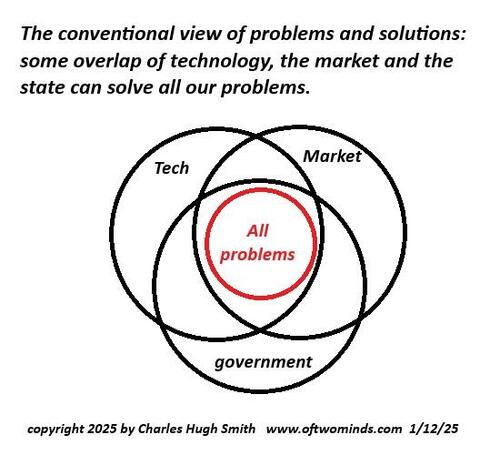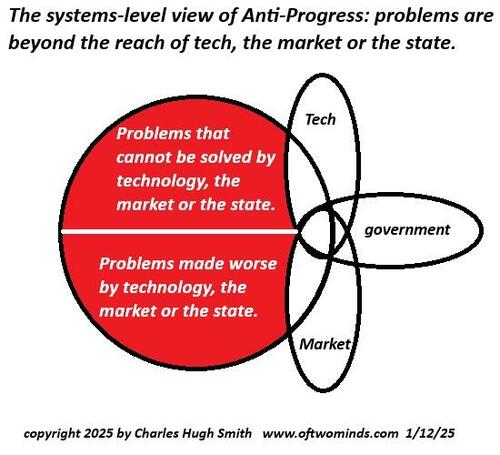What If Tech, The Market, & The State Are No Longer Solutions?
Authored by Charles Hugh Smith via OfTwoMinds blog,
If we study the problems outside the force-field of mythological beliefs, we find that there are no systemic solutions, there are only partial, local solutions.
The status quo rests on a foundational belief that all problems, regardless of their nature, can be solved by technology, the market or the government (i.e. the state), or some combination of these three.
Which one is the paramount solution depends on the specifics of the problem, of course, but what's proposed as a solution also depends on which of the three has gained our primary loyalty: to true believers in technology, there's always a tech fix. To true believers in the market, unleashing the market will fix any problem. To true believers in the power of the state, the Savior State is always the go-to solution.
These solutions transform from practical toolboxes into mythologies when they become simplified belief structures, in effect articles of faith populated with heathens, heretics, true believers, taboos and excommunication. The limits of each toolbox are set aside in favor of a belief in the unlimited magical powers of the tools.
We know we've entered the realm of mythologies when expressing doubts about the efficacy of tech, the market or the state unleashes an infuriated indignation that the gods of tech, the market and the state are being questioned, even as the proof of their powers are everywhere.
The difference between a toolbox and a mythology is every tool has limits, where mythology has no limits. If we're trying to drive nails with a handsaw, we're not going to find much success. We're forced to admit the tool isn't going to solve the problem.
But once we're embedded in a mythological structure, then we see play-acting as a legitimate solution. So a diesel-fueled robot that roams the fields zapping weeds with lasers is the "solution" to food insecurity. See, there's a tech solution to every problem. But the robot--AI!--can't make it rain, or stop the windstorm that destroyed the harvest, or nurture the depleted soil. The robot is a phantom solution, a "solution" that meets the requirements of the mythology--there must be a tech solution--but doesn't actually solve the problem of food insecurity, which is complex, structural and systemic.
Here is a Venn diagram of the status quo understanding of problems and solutions all problems exist within the loving embrace of tech, the market and the state, and therefore all problems can be solved by applying various mixtures of these three elixirs.
Here is the real-world situation, stripped of mythology and play-acting: the majority of the core problems are either made worse by tech, the market and the state--Anti-Progress writ large-- or they're beyond the reach of these conventional tools.
This Venn diagram causes howls of protest and shrieks of agony: how dare you! Of course there are tech solutions, market solutions and government solutions to every problem under the sun. What else is there?
What's missing from this faith in mythologies is the recognition that the conventional solutions must comply with implicit rules that limit their efficacy. Any "solution" must not disrupt the status quo's power structure, which has been over-optimized to the point of extreme fragility, a dynamic I discussed in Six Dynamics That Will Shape Our Future.
In other words, any "solution" must leave existing profit streams untouched and the power pyramid as-is. Given this constraint, and the fragility created by over-optimization, the only "solutions" that are acceptable to those at the top of the pyramid are play-acting "solutions", proposals presented as magical fixes that actually fix nothing, or create new problems--the definition of Anti-Progress.
To state this out loud is deeply offensive, for we've been trained to worship at the altars of technology, the market and the state. It's considered good sport to deride the limits of state solutions, but it's anathema to question the limits of technology or the market.
Markets only "solve problems" via infinite substitution of scarcities. OK, so we wiped out wild fisheries, the fix is fish farms. We bulldozed the native forests, the solution is tree farms. That each substitution isn't actually a functional substitute, and is a much lower quality that the original, is taboo.
That "the market solution" to declining profitability is monopoly (eliminating competition and transparency), addiction and reducing quality is also taboo.
What "problem" did social media solve? Or is social media now another "problem" that has no solution? But now that social media has created trillion-dollar enterprises, it can't be questioned as a "good thing." There are tech solutions, market solutions, state regulations--of course we can "fix" social media's Anti-Progress.
As with all "solutions" satisfactory to the system, all these "solutions" are play-acting: they sound good, everyone can click "like" or "heart" the "solution," but nothing actually changes.
If we study the problems outside the force-field of mythological beliefs, we find that there are no systemic solutions, there are only partial, local solutions that we put in place ourselves. Rather then expect tech, the market and the state to "fix" healthcare, we're better off accepting the system has no solutions because the profit streams and power structure are sacrosanct and cannot be touched, even though they're the source of the problem.
The only real, non-play-acting solution is to get healthy and reduce our dependence on "healthcare" to an absolute minimum. This approach applies to every problem in the red circle in the diagram above.
* * *
https://ift.tt/hrs6kxa
from ZeroHedge News https://ift.tt/hrs6kxa
via IFTTT



0 comments
Post a Comment